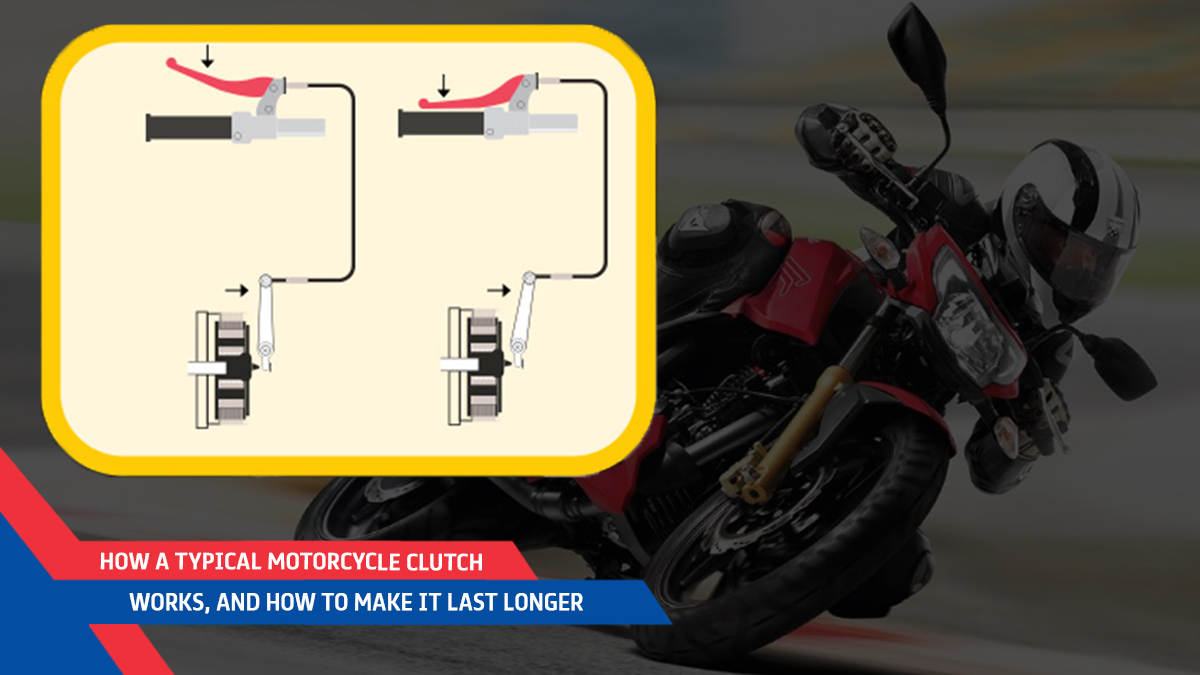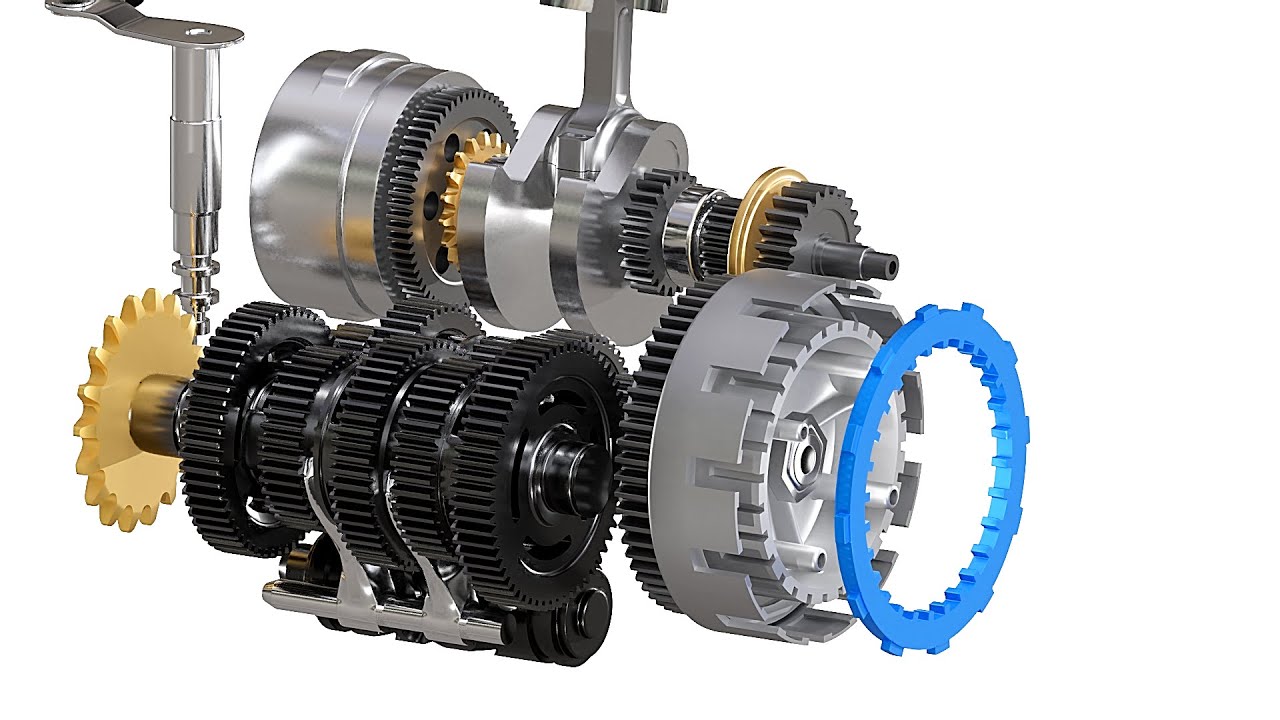A dirt bike clutch works by engaging and disengaging the power from the engine to the transmission. It allows the rider to change gears and control speed by connecting or disconnecting the engine’s power to the wheels.
When the clutch lever is pulled, it separates the clutch plates, stopping the transmission of power. When the lever is released, the plates come together, allowing the power to transfer from the engine to the wheels. This action lets riders smoothly shift gears, control acceleration, and navigate various terrains.
Understanding how the clutch works is essential for dirt bike riders to optimize performance and maintain control during off-road adventures.

Credit: www.tvsmotor.com
Components Of A Dirt Bike Clutch
A dirt bike clutch consists of several components that work together to engage and disengage power delivery to the rear wheel:
| Clutch Basket | Pressure Plate | Clutch Plates | Friction Plates | Springs |
|---|---|---|---|---|
| The clutch basket houses the clutch plates and is connected to the engine. | The pressure plate applies pressure to the clutch plates, allowing them to engage or disengage. | The clutch plates, also known as drive plates, are steel discs that transmit power from the engine to the transmission. | The friction plates, also known as driven plates, have a lining that grips the clutch plates to transmit power. | The springs provide tension to keep the clutch engaged when power is transmitted. |
The dirt bike clutch works by the rider pulling in the clutch lever, which releases the pressure on the clutch plates, allowing the engine to spin freely without transferring power to the rear wheel. Releasing the lever engages the clutch, connecting the engine to the transmission and delivering power to the rear wheel.
How Does The Dirt Bike Clutch Work?
The dirt bike clutch is a crucial component that allows riders to effectively control the power and speed of their bikes. Engaging the clutch is the first step in getting the bike moving. By pulling in the clutch lever, the clutch plates separate, allowing the engine to disengage from the transmission. This enables the rider to shift gears smoothly by simply releasing the clutch lever at the appropriate time. When the clutch lever is released, the clutch plates come together, connecting the engine and the transmission once again. This primary function of the clutch ensures power transfer and efficient acceleration.
The clutch lever also plays a vital role in disengaging the clutch entirely. When the lever is pulled all the way in, it disengages the clutch plates completely, preventing the engine power from reaching the transmission. This is particularly useful when the bike is at a standstill, as it allows the rider to keep the engine running without the bike moving.
The secondary function of the clutch is to control the power delivery to the rear wheel. By modulating the clutch lever, riders can find the optimal balance between power and control, especially in challenging terrains or tight corners. This precise control over the clutch lever enables riders to effectively manage the bike’s speed, acceleration, and stability.
Understanding how a dirt bike clutch works is essential for riders to maximize their enjoyment and performance on the tracks or trails. By mastering the art of engaging and disengaging the clutch and utilizing the clutch lever effectively, riders can harness the full potential of their dirt bikes.
How Does a Dirt Bike Clutch Work: Step by Step Guide
Working Principle Of A Dirt Bike Clutch
The dirt bike clutch operates based on the principle of friction and the transmission of power. When the rider engages the clutch lever, it disengages the clutch plates, allowing them to rotate freely. As the rider releases the clutch lever, the plates are pressed together by centrifugal force, creating friction and ultimately transferring power from the engine to the transmission.
This engagement of the clutch allows the rider to smoothly shift gears. It is important to note that the role of oil in the clutch operation cannot be underestimated. Oil lubricates the clutch plates, reducing friction and ensuring smooth operation. Additionally, it helps to dissipate heat generated during clutch engagement, preventing excessive wear and tear. Overall, the dirt bike clutch system is a critical component that enables precise control and efficient power transfer for an exhilarating off-road experience.
Wet Clutch Systems
The wet clutch system is commonly used in dirt bikes due to its efficiency and durability. Its construction and functioning are crucial to understanding how a dirt bike clutch works.
A wet clutch system consists of multiple steel plates interleaved with multiple friction plates. The friction plates are connected to the engine while the steel plates are connected to the transmission. When the clutch lever is pulled, it tightens the clutch springs and compresses the plates together.
This compression creates friction between the steel and friction plates, allowing power transfer from the engine to the transmission. The more the plates are compressed, the more power is transferred to the transmission, resulting in increased acceleration.
Advantages of a wet clutch system include improved heat dissipation, increased lifespan, and smooth engagement. However, it requires regular maintenance, such as changing the clutch oil and inspecting the plates for wear.
Maintenance and troubleshooting tips for wet clutch systems include checking the clutch lever play, adjusting the clutch cable tension, and inspecting the clutch plates for signs of slippage or wear.
Dry Clutch Systems
Dirt bike clutches play a crucial role in transferring power from the engine to the drivetrain. One type of dirt bike clutch is the dry clutch system. These clutches operate without any oil, making them lighter and more efficient.
The design and operation of dry clutch systems are relatively simple. They consist of several components, including the clutch basket, clutch plates, and pressure plate. When the rider pulls the clutch lever, the pressure plate pushes against the clutch plates, disengaging the engine power from the drivetrain. Releasing the lever allows the clutch plates to engage, transmitting power to the wheels.
One advantage of dry clutch systems is their responsiveness. They provide an instantaneous connection between the engine and the drivetrain, allowing for precise control. Additionally, dry clutch systems require less maintenance compared to wet clutch systems, as there is no need to change the clutch oil regularly.
However, there are some considerations for maintaining the longevity of dry clutches. It is important to keep the clutch basket and plates clean and free from debris or oil buildup. Regular inspections and adjustments to the clutch cable tension are necessary to ensure proper operation. By following these maintenance practices, dirt bike riders can enjoy the reliable performance of their dry clutch systems for years to come.
Regular Clutch Maintenance Practices
A dirt bike clutch is a crucial component that allows the rider to control the power and speed of the bike. Regular clutch maintenance practices are essential to ensure smooth and efficient performance. One such practice is the inspection and cleaning of the clutch assembly.
During inspection, it is important to check for any signs of wear and tear, such as grooves or burn marks on the clutch plates. Cleaning the clutch involves removing dirt and debris that may have accumulated over time, which can cause the clutch to slip or not engage properly.
Lubrication and adjustment are also important aspects of clutch maintenance. Applying lubricant to the clutch cable and pivot points helps reduce friction and ensures proper functioning. Additionally, adjusting the clutch cable tension is necessary to ensure smooth engagement and disengagement of the clutch.
Replacing worn-out components is crucial to maintain optimal clutch performance. Over time, clutch plates, springs, and other parts may become worn or damaged. Replacing these components when necessary helps to prevent clutch slippage and improve overall performance.
Common Clutch Issues And Solutions
A dirt bike clutch is an essential component that allows riders to effectively control their bikes. However, like any mechanical part, clutches can experience problems over time. Two common issues include slippage and grabbing, as well as dragging and stalling. Slippage and grabbing can occur when the clutch plates aren’t engaging smoothly, causing power loss and erratic bike behavior. This problem can often be resolved by adjusting the clutch cable or replacing worn-out plates.
Dragging and stalling, on the other hand, are typically caused by improper clutch adjustment or a worn-out clutch cable. This can result in difficult shifting and the bike stalling when coming to a stop. Correcting the clutch cable adjustment or replacing the cable completely can address these issues. Finally, noise and vibrations can also indicate a problem with the clutch, possibly due to a worn-out bearing or misalignment. If these symptoms persist, it’s recommended to have a professional mechanic inspect and repair the clutch to ensure optimal performance.
Troubleshooting Techniques For Clutch Problems
When a dirt bike clutch starts causing problems, identifying the root cause becomes crucial for efficient troubleshooting. Follow this step-by-step diagnostic process:
- Start by checking the clutch lever and cable for any signs of damage or wear. Ensure the cable is properly adjusted.
- Inspect the clutch plates for wear or warping. Replace them if necessary.
- Check the clutch springs for proper tension. Replace any weak springs.
- Examine the clutch basket and hub for excessive wear or damage, as it can affect clutch engagement.
- Inspect the clutch plates for oil contamination, which can cause slippage. Replace the plates and gaskets, and check for any engine oil leaks.
- If all else fails, it’s recommended to seek professional help or consider self-repair options. Replacing the entire clutch assembly might be required in more severe cases.
By following these troubleshooting techniques, you can effectively diagnose and resolve clutch issues in your dirt bike. Remember to always prioritize safety and seek expert assistance when needed.
Frequently Asked Questions Of How Does A Dirt Bike Clutch Work
What Does The Clutch Do On A Dirt Bike?
The clutch on a dirt bike allows the rider to control the transfer of power from the engine to the wheels.
Do You Pull In Clutch To Start Dirt Bike?
No, you do not pull in the clutch to start a dirt bike.
How Does The Clutch Work On A Motorcycle?
The clutch on a motorcycle works by disengaging and engaging the engine from the transmission to change gears.
How Do I Know If My Dirt Bike Clutch Is Worn Out?
To determine if your dirt bike clutch is worn out, look for signs of slipping, difficulty shifting gears, or a burning smell.
Conclusion
Understanding how a dirt bike clutch works is essential for any rider, whether you’re a beginner or an experienced rider. A clutch is a vital component of a dirt bike, allowing you to change gears smoothly and control the power delivery to the wheels.
By engaging and disengaging the clutch, you can manage the torque and speed of your bike, enabling you to conquer different terrains and navigate obstacles. It’s important to know the basics of the clutch system, including the clutch plates, clutch basket, and clutch lever, to ensure proper maintenance and avoid costly repairs.
Regularly inspecting and lubricating your clutch components can maximize its lifespan and performance. So, whether you’re hitting the trails, competing in motocross, or traversing uneven terrains, a deep understanding of how a dirt bike clutch works will make your riding experience safer and more enjoyable.
Happy riding!

